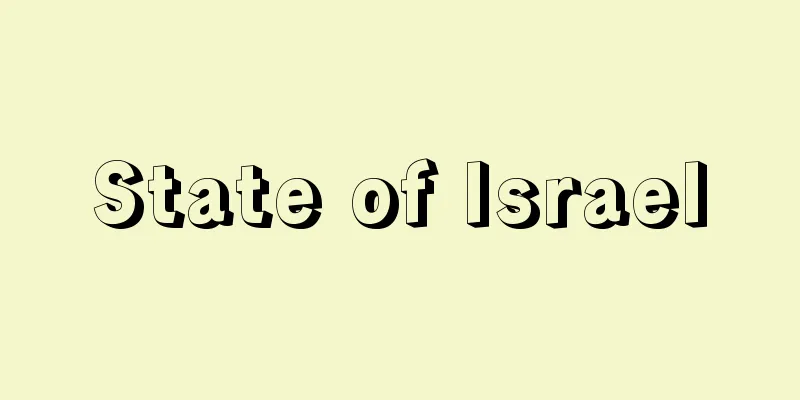State of Israel

|
A republic in Palestine in Southwest Asia. Its official name is Medinat Israel (State of Israel). It is the only country on Earth with a Jewish majority, located on the eastern shore of the Mediterranean Sea and surrounded by Arab countries Lebanon to the north, Syria and Jordan to the east, and Egypt to the south. Its area is 22,072 square kilometers (including East Jerusalem and the Golan Heights, which Israel has declared annexed), almost the same as Shikoku. Its population is 7,374,000 (2008). During the Six-Day War in 1967, Israel seized the West Bank, including East Jerusalem, from Jordan, and then the Golan Heights from Syria, and the Gaza Strip and the Sinai Peninsula from Egypt. In accordance with the peace treaty with Egypt, it completed the return of the Sinai Peninsula in 1982. However, it has declared the annexation of East Jerusalem, including the Old City, which is historically important as a holy site, and the Golan Heights, which it seized from Syria. This has not been recognized by the international community. The name Israel was originally the name of a tribal alliance of Israel, but later became the name of an ethnic group based on the faith in Yahweh, that is, the Israelites. It means "God (Ael) rules," and indicates the idea of a theocratic government. Some interpretations say it means "God wins," "competing with God," or "clinging to God." Later, the name Israel (people) came to be used as a national name for the entire ethnic group. [Kazuo Takahashi] Nature and GeographyThe topography of the area under Israeli control can be divided into four zones: the central hill region stretching from Lebanon in the north to the Negev Desert in the south; the plains on the west bank of the Jordan River; the coastal plain between the hill region and the Mediterranean Sea; and the Negev Desert in the south. The northern Galilee region of the Central Hills has a Mediterranean climate, is blessed with fertile soil, and is known for the cultivation of olives and tobacco. Arab residents are concentrated in this region, and its central city is Nazareth, where Jesus Christ is said to have grown up. The Emek Valley, which runs northwest from the Jordan River basin to just north of Haifa on the Mediterranean coast, divides this Central Hills region into north and south. Due to its hot and humid climate, this region was once a marshland where there was even a risk of malaria, but it is now Israel's grain-producing region. The hills south of the Emek Valley were the center of both the Jewish and Israeli kingdoms in ancient times. Important cities include Jerusalem and Ramla. There is a plain along the west bank of the Jordan River. The Jordan River, which originates on Mount Hermon on the Syrian-Lebanese border, flows 117 km through Israeli territory, then crosses the border, separating the West Bank from Jordan, and flows into the Dead Sea. This has led to conflicts over water rights between Syria, Lebanon, Jordan, the Palestinian Authority, and Israel. The northern part of the plain is a rich agricultural region, and contains Lake Tiberias (Sea of Galilee), an important water source for Israel. The lake's water level is about 212 meters below sea level. As one travels south along the Jordan River, the land becomes barren, and at the southern end is the Dead Sea, the lowest salt lake on Earth, 400 meters below sea level. Projects are underway to recover resources such as salt, potassium, and bromine from the Dead Sea. The Mediterranean coastal plain is Israel's heartland, containing the main port of Haifa, the embassy city of Tel Aviv, and is both an industrial and fruit-growing center. The Negev Desert, which occupies more than half of the country's land area, spreads in the south. The annual rainfall is 200 mm in the north and only 25 mm in Eilat at the south end. The Israeli government has actively promoted the development of the Negev Desert by drawing water from the north. The main cities are Beersheba and Dimona. Nuclear facilities, including a nuclear reactor, are located on the outskirts of Dimona. The port city of Eilat is Israel's only outlet to the Gulf of Aqaba and is an important location militarily, economically, and psychologically. Before the Iranian Revolution, Iranian crude oil was imported from the port of Eilat and sent via pipeline to the port of Haifa on the Mediterranean Sea, where it was re-exported to Eastern European countries such as Romania. One of the direct causes of the Third Arab-Israeli War was Egypt's announcement of the blockade of the Straits of Teran, which is the entrance from the Gulf of Aqaba to the Red Sea. [Kazuo Takahashi] historyA History of Exile and PersecutionIt is believed that the ancestors of the Jews, the Israelites (Hebrews), settled in Palestine, which was called the land of Canaan, around the 20th century BC, and established the Kingdom of Israel in the 11th century BC. In the first half of the 10th century BC, this was divided into the Kingdom of Israel and the Kingdom of Judah, and after these two countries were destroyed by Assyria and Neo-Babylonia, respectively, the Kingdom of Judea was established under the protection of the Roman Empire in the 1st century BC. However, because they resisted the imperial power of Rome, they were thoroughly oppressed by Rome. Then, in 135 AD, Rome finally banned the Jews from entering Jerusalem. This is said to have been the beginning of the history of the Jewish world wanderings. The Jews in Europe in particular had to endure repeated persecutions. With this history of hardship as an undercurrent, in the late 19th century, a movement to establish their own country arose among the Jews who could not assimilate into Christian society, or were not allowed to assimilate. The background to this was the rise of nationalism in 19th century Europe, where each ethnic group aspired to their own country. The Beginnings of Zionism and the Conflict with the PalestiniansThe land that the Jews ultimately sought to establish their own nation was Palestine, which was then part of the Ottoman Empire. And Mount Zion, another name for Jerusalem, was the symbol of their aspirations for building a nation. For this reason, this movement was called "Zionism," a movement to return to the land of Mount Zion, and its promoters were called "Zionists." As the tide of Jewish persecution in Europe rose, Zionists flowed into Palestine. However, it was not an uninhabited land. It was inhabited by Palestinians (mainly Arabs such as Muslims and Christians), and their rebellion was inevitable. When World War I began, Britain supported the Arab revolt in the Ottoman Empire, an ally of Germany, and promised the independence of an Arab state after the war. The Arabs perceived this state to include Palestine. On the other hand, Britain also sought Zionist cooperation in the war, and in return issued the Balfour Declaration in 1917, supporting the establishment of a "national home" for the Jews in Palestine. However, after the war ended, Palestine came under British rule in the form of a mandate. As the Nazis gained power in Europe in the 1930s, Jewish immigration to Palestine increased. German Jews in particular brought capital and technology to Palestine, and the Jewish community there grew significantly. For example, it was during this period that the Palestine Symphony Orchestra, the precursor to the Israel Philharmonic Orchestra, was founded. As the Jewish population grew, Palestinian resentment also grew, and the friction between the two sides escalated into armed conflict. The Nazis' massacre of the Jews (the Holocaust) during World War II spurred Zionist activities. In addition, sympathy for the Jews increased in Europe and North America. After the war, armed conflict in Palestine intensified, and terrorist attacks on British authorities became frequent. Israeli Independence ~ Middle East WarIn the midst of this chaos, Britain announced that it would leave the future of Palestine to the United Nations, conveniently pushing the solution of the difficult problem onto the international community. The UN General Assembly passed a resolution to divide Palestine into an Arab region, a Jewish region, and an internationally administered region. The Zionists accepted this and declared the establishment of their long-desired Jewish state, Israel (1948). The Arab side rejected the partition plan, and the armies of surrounding Arab countries invaded Palestine, starting the First Arab-Israeli War (1948-1949). The Israeli army defeated the Arab armies and secured more territory than was given to them in the partition plan. In the process, many Palestinians were driven out of Israeli-controlled areas. Conversely, anti-Semitic sentiment intensified in Arab countries, and many Jews immigrated to Israel. The Israeli government enacted the Law of Return, which granted all Jews the right to immigrate to Israel and obtain citizenship, and accepted Jews from Arab countries and all over the world. This led to a rapid increase in the Jewish population in Israel. Thus, the Zionist state was established and developed on the basis of depriving the Palestinians of their rights, who had their land and property stolen and become refugees. Meanwhile, the Arab world demanded the restoration of Palestinian rights, and there were three major armed conflicts between the two sides: the Second Arab-Israeli War (1956), the Third Arab-Israeli War (1967), and the Fourth Arab-Israeli War (1973). In particular, Israel won a crushing victory in the 1967 war in just six days, and expanded its territory as mentioned above. However, in the 1973 war, Israel suffered heavy losses after a surprise attack by the Syrian and Egyptian armies. Moreover, in reaction to the US's emergency military aid to Israel, Arab oil-producing countries announced a series of measures, including a ban on oil exports to the US and the Netherlands, and a reduction in exports to unfriendly countries. This became known as the "Arab Oil Embargo," and it shocked the Western industrial countries, which had become increasingly dependent on Arab crude oil, bringing about the so-called "oil shock." However, Israel's counterattack was ultimately successful, and this war also ended in a tactical victory for Israel. However, the Arabs' early successes shattered the myth of Israeli invincibility, and the oil embargo increased their international influence. Peace Negotiations - Camp David AccordsAfter the fighting subsided, Secretary of State Henry Kissinger of the Nixon administration attempted a "step-by-step" approach to peace. This was a series of small compromises aimed at reaching a final solution. Kissinger's vigorous efforts, known as "shuttle-dialogue," achieved the separation of Arab and Israeli forces in the Sinai Peninsula and the Golan Heights. Kissinger's diplomacy was succeeded by the Carter administration's comprehensive peace plan, which emerged in 1977. This was an attempt to pave the way for peace in one fell swoop by convening the relevant countries and organizations in Geneva. However, negotiations ran into difficulties, partly due to the formation of the hard-line Begin cabinet in Israel. Amid this stagnation in peace diplomacy, Egyptian President Sadat visited Jerusalem in 1977, opening a new phase, and the following year, in 1978, a meeting was held between the leaders of Israel, Egypt, and the United States, at which an agreement was reached. This agreement was called the Camp David Accords after the name of the US presidential residence where it was held, and it consisted of two parts. One part provided for a peace treaty between Israel and Egypt, an exchange of ambassadors, and the return of the Sinai Peninsula to Egypt, while the other part provided for negotiations for the establishment of Palestinian self-government. With this agreement, Israel succeeded in normalizing relations with an Arab country for the first time. During this time, President Sadat was assassinated (1981), but Israel overcame this obstacle and completed the complete return of the Sinai Peninsula to Egypt in April 1982 as agreed. Invasion of LebanonThe Camp David Accords relieved military pressure from Egypt. Israel seized this opportunity to invade Lebanon in June 1982. After sweeping through southern Lebanon, the Israeli army surrounded Beirut. The objectives of this operation were to wipe out the Palestine Liberation Organization (PLO) from Lebanon, secure the security of northern Israel, strike a blow to the Palestinian national movement, and establish a pro-Israeli government in Lebanon. The PLO was evacuated from Beirut through the mediation of the United States. After that, Lebanese Christian forces allied with Israel carried out massacres in Sabra and Shatila, Palestinian refugee camps on the outskirts of Beirut. As a result, the Israeli government received strong criticism from both inside and outside the country. After the withdrawal of the PLO, the Israeli army continued to occupy southern Lebanon, but was met with strong opposition from the Shiite Muslim population. After losing many soldiers to the Shiite guerrillas' lethal attacks, the Israeli army withdrew from most of Lebanon in 1985. However, the southernmost part of Lebanon continued to be occupied as a "security zone." The Israeli army and the "South Lebanon Army," which it organized as mercenaries, continued to fight fiercely against guerrillas from the Shiite organization Hezbollah, but the high number of casualties led to growing public opinion within the country calling for their withdrawal. The outbreak of the Intifada - Towards the Palestinian Interim Self-Government AgreementAt the end of 1987, a large-scale resistance movement by residents of the Gaza Strip and the West Bank, known as the Intifada (popular uprising), spontaneously broke out. Eventually, the PLO and Hamas (Islamic Resistance Movement) began to organize this movement. The intensity and tenacity of the resistance aroused public opinion both inside and outside Israel calling for an end to the occupation. The Gulf Crisis, which began with Iraq's invasion of Kuwait in August 1990, turned into the Gulf War in January 1991 with the attack of multinational forces. Iraq attacked Israel with improved Soviet-made Scud missiles. Israel was inclined to retaliate, but was persuaded by the United States not to join the war. In October of the same year, the United States led the International Conference on Middle East Peace in Madrid. However, the Israeli government was not prepared to make territorial concessions, which was a prerequisite for achieving peace, and the conference made no progress. The following year, in the June 1992 general election, Yitzhak Rabin's Labor Party won. Rabin was the Chief of Staff during the 1967 Six-Day War and is a hero who led Israel to a historic victory. In 1993, Israel and the PLO began secret negotiations with Norway as an intermediary, and reached an agreement in August of that year in Oslo, the capital of Norway. The following September, PLO Chairman Arafat and Israeli Prime Minister Rabin signed the agreement document and exchanged historic handshakes at the White House in Washington, with US President Clinton and others watching. The document stipulated mutual recognition of the PLO and Israel, the start of Palestinian self-governance in the Gaza Strip and the West Bank city of Jericho, and the determination of the final status of the occupied territories through negotiations. Based on this Palestinian Interim Self-Government Agreement (Oslo Accords), Palestinian self-governance actually began in 1994 in the Gaza Strip and Jericho. Stalled peace talksIn 1995, Prime Minister Rabin, who had been promoting peace talks, was assassinated. The assassin was a Jew who opposed withdrawal from the occupied territories. Shimon Peres, who succeeded Rabin, continued the peace policy and withdrew Israeli troops from most of the major cities in the West Bank, except for Jerusalem and Hebron. In January 1996, Palestinian Council elections were held. However, in June of the same year, after a close race, Benjamin Netanyahu of the right-wing Likud party was elected as Israel's first prime minister. Netanyahu pursued a policy that put security at the forefront in order to suppress frequent terrorist attacks. In January 1997, in agreement with PLO Chairman Arafat, 80% of Israeli troops were withdrawn from Hebron in the West Bank, but in March of the same year, Israel built a Jewish settlement on the southern edge of East Jerusalem, which provoked strong opposition from the Palestinian side, and the Middle East peace process stagnated. Furthermore, there were a series of incidents that drew international condemnation, such as the attempted assassination of a Hamas leader in Jordan by agents of the Israeli secret service, Mossad (1997), and the discovery of wiretapping in Switzerland (1998). Wai Agreement concluded - "Roadmap" presentedIn October 1998, the Palestinian Authority signed the Wai Agreement with Arafat to advance the stalled Middle East peace process. The Wai Agreement included a new withdrawal of Israeli troops from 13% of the West Bank, and expanded the autonomy of the Palestinian Authority. However, after the withdrawal of 2% in November of that year, a bill was passed in Israel to bring forward the direct election of the prime minister and the general election of the parliament, effectively freezing the withdrawal. On the Palestinian side, in December 1998, the Palestinian National Council (PNC), witnessed by US President Clinton, decided to formally abolish the clause in the Palestinian National Charter that calls for the destruction of Israel. In the election held in May 1999, Ehud Barak (1942- ), from the Labor Party, the largest opposition party promoting Middle East peace, defeated Netanyahu and was elected, and in July of the same year became prime minister and minister of defense. Barak resumed the stalled peace talks, concluded a new Israeli-Palestinian agreement, and entered into "final status negotiations" in November 1999. In July 2000, Clinton invited Barak and Arafat to Camp David for a summit, but the talks ended in failure. In September of the same year, Ariel Sharon, leader of the right-wing Likud Party, forced a visit to the Temple Mount, a holy site in the Old City of Jerusalem, which led to intensified conflict between Israel and Palestine. In the public election the following February 2001, Sharon, a hard-liner against Palestine, defeated Barak and became prime minister, forming a coalition government with the Labor Party and others. In June 2002, Israel erected a separation fence between the West Bank and Israeli territory, citing the need to protect against attacks by Palestinian extremists, and the Palestinians criticized its unilateral construction. In October of that year, the Labor Party withdrew from the coalition government, leaving the ruling party with less than a majority, and Sharon attempted to form a coalition with the far-right, but failed, and dissolved parliament. In the general election in January of the following year, 2003, the Likud Party won, and party leader Sharon became prime minister again. In April of that year, a new peace plan, the "Roadmap," was presented by the United States, the EU (European Union), Russia, and the United Nations, and was accepted by both Israel and Palestine, but terrorist attacks and retaliatory attacks continued to occur. Withdrawal from GazaOn the Palestinian side, Abbas became leader following the death of Arafat in 2004. In January 2005, a new coalition government consisting of Likud, the Labor Party, and the Religious Party of the United Tribunal (UTJ) was formed in Israel, and in February of the same year, Sharon met with Abbas in Sharm el-Sheikh, Egypt, where the two leaders confirmed their commitment to the peace process based on the roadmap, and in September of the same year, Israeli troops completed their withdrawal from the Gaza Strip. The Rise of HamasWhen the Labor Party withdrew from the coalition government in November 2005, Sharon left Likud to form a new centrist party, Kadima. However, in January 2006, Sharon suffered a stroke and was rushed to hospital, effectively retiring from politics, and Acting Prime Minister Olmert took over as acting prime minister. In the general election in March of that year, Kadima became the leading party, and in May of the same year, Olmert officially became prime minister. Meanwhile, in Palestine, the Islamic fundamentalist organization Hamas took part in the Palestinian Council elections held in January 2006 for the first time, and received more support than Fatah, which had been the mainstream until then, and became the leading party, winning 74 of the 132 seats in the parliament. Invasion of Southern LebanonOn July 12, 2006, the Shiite militia group Hezbollah kidnapped two Israeli soldiers in the Lebanon-Israel border area, and the Israeli army launched an invasion of southern Lebanon. Israeli airstrikes caused many civilian casualties, drawing criticism from the international community. Following a UN Security Council resolution, a ceasefire went into effect on August 14 of the same year, and on October 1, Israeli forces stationed in southern Lebanon withdrew and handed over areas under their control to the United Nations Interim Force in Lebanon (UNIFIL), but Israel was unable to disarm Hezbollah. Armed conflict with HamasMeanwhile, in the Palestinian territories, Hamas took control of Gaza in June 2007, and armed conflict between Israel and Hamas has continued since then. At the Annapolis International Conference on Middle East Peace in November of the same year, it was agreed to resume peace talks, but the peace process did not progress. A six-month ceasefire between Israel and Hamas established in June 2008 also expired, and no agreement was reached on an extension, leading to intensified armed attacks by both sides. An interim ceasefire was agreed upon on January 18, 2009, but there is no prospect of a permanent ceasefire. PoliticsThe political system is a democratic republic with no written constitution. The Knesset, a parliament with 120 seats, is the highest organ of the country, and its members are elected by vote of citizens over the age of 18. Votes are cast not for individuals but for political parties, and seats are distributed in proportion to the percentage of votes received, under a fully proportional representation system with one nationwide district. Under this system, there are almost no wasted votes, which is why political parties are numerous. It is even said with some exaggeration that "two Jews can produce three political parties." No political party has ever held a majority in the Knesset on its own, and coalition governments are usually in charge of government. This makes cooperation among smaller parties essential. Religious parties with few seats in parliament have taken advantage of this situation by joining coalition governments in exchange for conditions such as subsidies for religious education institutions. The system was changed in the 1996 elections, and direct public election of the prime minister was introduced, with voters choosing the prime minister and members of parliament separately. As mentioned above, the result was that Likud leader Netanyahu was elected prime minister, and although Likud fell two seats short of the leading Labor Party, a Netanyahu government was formed in coalition with religious parties including Shas and other right-wing parties. However, the government was shaken by the defection of Foreign Minister Levi in January 1998 over budget allocation, followed by the defection of Defense Minister Mordechai in January 1999, who was known as the only peace advocate under Netanyahu, who made maintaining security his top priority. In the direct election for the prime minister and the general election for the National Assembly held in May 1999, Barak, leader of the Labor Party, which advocated Middle East peace, was elected prime minister, and a new government was formed with "One Israel" (a coalition of three parties including the Labor Party) at its core. Then, in the direct election for prime minister in February 2001, Sharon, leader of the Likud Party, defeated Barak to become prime minister, and the Sharon administration (coalition cabinet) was formed. While Barak, a moderate, advocated dialogue with Palestine, Sharon implemented a hard-line policy towards Palestine. The system of direct election of the prime minister was abolished in March 2001. In the general election held in January 2003, Sharon's Likud Party won, and Sharon was reappointed Prime Minister. Initially, a coalition government of four center-right parties was formed, but three of them left the coalition, and in January 2005, a new coalition government was formed by Likud, the Labor Party, and a religious party. However, in November of the same year, the Labor Party left the coalition government. Sharon left the Likud Party due to a policy conflict within the Likud regarding the withdrawal from Gaza, and announced the formation of the centrist party Kadima. As a result, parliament was dissolved and general elections were held ahead of schedule, but in January 2006, Sharon suffered a stroke and fell into a critical condition, and Olmert became Kadima's successor leader. In the general election held in March of the same year, the Likud Party became the largest party, and in May Olmert became Prime Minister, forming a coalition government with the Pension Party, the Labor Party, and others. In September 2008, Olmert announced his intention to resign. Following the general elections in February 2009, Netanyahu was once again elected prime minister and took control of the government in March of that year. [Kazuo Takahashi] DiplomacyIn the background of the conflict with Arab countries that denied the right of the Zionist state to exist, Israel's biggest diplomatic goal was its survival and international recognition. Immediately after its founding, Israel established diplomatic relations with North American and European countries, and in the 1960s, it established diplomatic relations with many of the newly independent Asian and African countries. The economic and technical assistance provided by Israel played a major role in this. It is also noteworthy that Israel accepted assistance from West Germany in the late 1950s, and formally established diplomatic relations in the 1960s. However, after the 1967 war, Eastern European countries, except Romania, severed diplomatic relations with Israel. In the 1970s, economic assistance from Arab oil-producing countries to Black African countries such as Libya increased sharply, far exceeding that of Israel. This was the main reason that these countries one after another decided to break off diplomatic relations with Israel. Arab countries, working in tandem with these Black African and socialist countries, have passed anti-Israel resolutions one after another at the United Nations. Moreover, when the monarchy in Iran, which had close military and economic ties with Israel and was its largest oil supplier, collapsed in 1979, the new government decided to sever diplomatic relations with Israel. In this harsh international environment, Israel's greatest ally is the United States. By 1998, the United States had provided Israel with a total of $80 billion in aid, both paid and unpaid, and had supported the Jewish state behind closed doors, including by vetoing resolutions unfavorable to Israel at the UN Security Council. Behind this American support for Israel is the political power of the approximately 6.5 million Jewish citizens living in the United States. Furthermore, after the end of the Cold War, Eastern European countries one after another restored diplomatic relations with Israel. Resumption of diplomatic relations with African countries also progressed. [Kazuo Takahashi] MilitaryIn order to counter Arab countries that have an overwhelming population advantage, Israel is making every effort to maintain a strong military force. The Israeli military is composed of three components: about 60,000 professional soldiers, about 117,000 soldiers currently serving, and about 408,000 reservists. The country has a universal conscription system, and when men reach the age of 18, they are required to serve for three years, and women for 19 to 24 months. However, only Arab citizens who are Druze are called up. Students of Jewish seminaries are also exempt from military service. After completing their military service, they are transferred to the reserves, where men receive training for about one month each year until they are 40 (45 for officers), and women until they are 38 or until they get married. The regular army consists of 133,000 soldiers. In addition, there are 10,000 naval personnel, 34,000 air force personnel, and a total of 177,000 soldiers in the army, navy, and air force (2006). If we call up a reserve, approximately 590,000 people will be able to mobilize within a short period of time. Due to the small population, the long-term mobilization of large troops is too heavy, so Israel's strategy is a short-term battle. Furthermore, the difference in troops with the Arab side is compensated for by organisational strength, soldier qualities, and weapons. The weapons are mainly made in the United States. The Israeli military is the best in the Middle East, regardless of whether it is equipment, training, morale, or practical experience. Mossads are also involved in intelligence activities in Arab countries and around the world. Furthermore, it is suspected that they possess nuclear weapons. [Takahashi Kazuo] Economy and IndustryPalestine has been known as a rich land since ancient times. Zionists have used advanced technology to further develop agriculture in this area. Citrus and other citrus are exported to Europe and elsewhere. Industry is also showing remarkable development. The diamond polishing industry is well-known and boasts a larger scale than the Netherlands and Belgium, the traditional centers of the industry. One of the most popular items is the weapons industry. For military reasons, the domestic production of weapons has been promoted, and exports are encouraged to procure weapon development costs. Furthermore, since the late 1980s, the high-tech sector, such as computer software, has grown significantly. Reflecting the development of this industry and aid from overseas, Israel's GDP reached $161.8 billion (2007) and gross domestic product per person of 21,900 (2007). Trade (2006) was 46.55 billion dollars and imports of 47.75 billion dollars, with imports of 47.75 billion dollars, and imports of 2006 include diamonds, machinery, chemicals, agricultural products, and other imports of automobiles, machinery, optical and medical devices, chemicals, and other products. The main export partners are the United States and EU countries, which account for approximately 65% of exports. The main import partners are the EU countries, the United States, and China. [Takahashi Kazuo] Society and CultureAt the time of the nation's founding, the majority were European Jews (Ashkenazim). Later, Asian and African Jews, especially the Middle Eastern Jews (Sephardims), were influxed. However, Ashkenazims account for the majority of Israel's upper classes, and there are dissatisfactions among the Sephardims. As the 1990s began, a new wave of immigration arrived in Israel: Soviet Jews. The flow of people continued even after the Soviet Union disappeared, and by 1994, 600,000 people had moved to Israel. One change in Israeli society is that religious forces seeking to preserve the Jewish tradition have grown their influence. For example, they have been receiving backlash from secular Jews for trying to ban Jerusalem's district on the Jewish Sabbath. And the majority of secular American Jews are beginning to feel uncomfortable with these changes in Israel. Nearly 20% of the population are Palestinians and their descendants who remained citizens of Israel without leaving their homes when Israel was founded. The official languages are Hebrew and Arabic. English is also widely used. Compulsory education is for 11 years, between the ages of 5 and 15, and there are eight universities, including the Hebrew University in Jerusalem and the Institute of Technology in Haifa. In addition, there are Palestinian universities in the Gaza Strip and the West Bank. Although Jews are the main religion, Arabs are Muslims, Christians and Druzes. In Haifa on the Mediterranean coast, the headquarters of the Bahai Cultural Cult is located. [Takahashi Kazuo] Relations with JapanSince the 1973 oil crisis, Japan has not always been actively strengthening relations due to consideration for Arab oil-producing countries. However, since the end of the 1980s, Japan has been changing its policy towards Israel to strengthen relations. Japan has exported automobiles, mechanical, electrical equipment, and other things, while Israel has exported optical and medical devices, gemstones and precious metals to Japan, and is hoping for Japan as a market for high-tech products. The export value to Japan is 810 million dollars and import value is 1.29 billion dollars (2006). In addition, Japan has provided a large amount of assistance to the Palestinian Autonomous Government to support the Middle East peace. [Takahashi Kazuo] "D. Grossmann, "Palestinians in the Jewish State" (1997, Shobunsha)" ▽ "Matsuyama Kenji, Armed Conflict Law and the Israel-Palestine Conflict (2008, University Education Publishing)" ▽ "Martin Gilbert, "The Complete History of Israel" (2008, Asahi Shimbun Publishing)" ▽ "Takahashi Kazuo, "Arab and Israel: The Constitution of the Palestinian Issues" (Kodansha Gendai Shinsho)" ▽ "Tateyama Ryoji, "Israel and Palestine: Finding the Points of Integration to Peace" (Chuko Shinsho)" ▽ "Israel: The Issue by Kuritanigawa Fukuko, "Israel: The Issue" (Iwanami Gendai Bunko)" ▽ "Israel" (Iwanami Gendai Bunko) " ▽ "Israel" (Iwanami Shinsho)" [References] | | | | | | | | | | | | | | | | Galilee | | | | | | | | | | | | | | | | | | | | | | | Hezbollah | | | | | | | | | | | | | Complementary Materials] |"> Israeli flag ©Shogakukan Illustration/Shogakukan Creative "> Israel location map Source: Shogakukan Encyclopedia Nipponica About Encyclopedia Nipponica Information | Legend |
|
西南アジアのパレスチナにある共和国。正式名称はイスラエル国Medinat Israel(State of Israel)という。地球上でユダヤ人が多数派の唯一の国で、地中海の東岸に位置し、北はレバノン、東はシリア、ヨルダン、南はエジプトのアラブ諸国によって取り囲まれている。面積は2万2072平方キロメートル(イスラエルが併合を宣言した東エルサレム、ゴラン高原を含む)で四国とほぼ同じ。人口は737万4000(2008)。 1967年の第三次中東戦争の際に、イスラエルは東エルサレムを含むヨルダン川西岸地区をヨルダンから奪い、さらにゴラン高原をシリアから、ガザ地区とシナイ半島をエジプトから奪った。その後エジプトとの平和条約に従って1982年にシナイ半島の返還を完了した。しかし、聖地として歴史的に重要な旧市街を含む東エルサレムと、シリアから奪ったゴラン高原の併合を宣言している。国際社会はこれを認めていない。 イスラエルという名称は、元来イスラエルの部族同盟の名称であったものが、のちにヤーウェ信仰に立脚した民族集団すなわちイスラエル民族の名称となったもので、「神(エール)が支配する」という意味をもち、神政政治の理念を示している。「神が勝つ」「神と競う」「神に固執する」などの意味をもつとする解釈もある。その後、イスラエル(人)という名は全民族に対する国民的な名称として用いられるようになった。 [高橋和夫] 自然・地誌イスラエルの支配する地域の地形は、北はレバノンから南はネゲブ砂漠にまで連なる中央丘陵地帯、ヨルダン川西岸の平野、丘陵地帯と地中海に挟まれた海岸平野、南部のネゲブ砂漠の四つに区分できる。 中央丘陵地帯の北部ガリラヤ地方は地中海性の気候帯に属し、肥沃(ひよく)な土壌に恵まれ、オリーブとタバコの栽培で知られる。アラブ系住民はこの地域に集中しており、イエス・キリストが育ったといわれるナザレがその中心都市である。ヨルダン川流域から北西に走り地中海沿岸のハイファ北方に至るエメク峡谷が、この中央丘陵地帯を南北に分断している。この地方は高温多湿の気候のため、かつてはマラリアの危険さえある湿地帯であったが、現在はイスラエルの穀倉地帯になっている。エメク峡谷南部の丘陵地帯は古代にはユダヤ、イスラエル両王国の中心地であった。重要都市はエルサレム、ラムラーなどである。 ヨルダン川の西岸に沿って平野部がある。シリア・レバノン国境のヘルモン山に水源を発するヨルダン川はイスラエル領内を117キロメートル流れ、その後、国境を越え、ヨルダン川西岸地区とヨルダンとを隔てて、死海へと流れ込む。このため水利権をめぐりシリア、レバノン、ヨルダン、パレスチナ自治政府とイスラエルとの主張が対立している。この平野の北部は豊かな農業地帯で、イスラエルにとって重要な水源であるティベリアス湖(ガリラヤ湖)がある。同湖の水面は海面下約212メートルにある。ヨルダン川に沿って南部にいくにしたがって土地は不毛になり、南端には海面下400メートルという地球上でもっとも低い塩湖、死海がある。この死海から塩、カリウム、臭素などの資源を回収する事業が行われている。 地中海岸の平野部はイスラエルの心臓部である。主要港のハイファ、各国が大使館を置くテル・アビブを含み、工業地域であると同時に果樹栽培の中心地でもある。 南部には国土の半分以上を占めるネゲブ砂漠が広がる。年降水量は北端で200ミリメートル、南端のエイラトではわずか25ミリメートルにすぎない。イスラエル政府は北部から水を引き、ネゲブ砂漠の開発を活発に進めてきた。中心都市はベールシェバ、ディモナなどである。ディモナの郊外には原子炉を含む核関連施設がある。港湾都市エイラトは、イスラエルにとってはアカバ湾への唯一の出口であり、軍事的、経済的また心理的にも重要な地点である。イラン革命以前は、イラン原油をエイラト港から輸入しパイプラインで地中海のハイファ港に送り、ルーマニアなどの東ヨーロッパ諸国へ再輸出していた。また第三次中東戦争の直接の原因の一つとなったのは、エジプトがアカバ湾から紅海への出入口であるテラン海峡の封鎖を発表したことであった。 [高橋和夫] 歴史流浪と迫害の歴史ユダヤ人の祖先イスラエル人(ヘブライ人)が、カナーンの地と称されていたパレスチナに定住したのは紀元前20世紀ごろとみなされており、前11世紀にはイスラエル王国を建設している。前10世紀前半にはこれが分かれてイスラエル王国とユダ王国とになり、この2国がアッシリア、新バビロニアによってそれぞれ滅ぼされてのち、前1世紀にはローマ帝国の保護下にユダヤ王国が樹立された。しかしローマの帝権に抵抗したためローマの徹底した弾圧にあった。そして紀元後135年に、ローマはついにユダヤ人がエルサレムに入ることを禁じた。ここにユダヤ人の世界流浪の歴史が始まったとされる。とくにヨーロッパのユダヤ人は、繰り返し起こる迫害に耐えなければならなかった。こうした苦難の歴史を底流として19世紀後半に入ると、キリスト教社会に同化できなかった、また同化を許されなかったユダヤ人の間に自らの国を建設しようとする運動が沸き起こってきた。この背景には、19世紀のヨーロッパにおける、各民族が固有の国家を希求する民族主義の高揚があった。 シオニズムの始まりとパレスチナ人との対立ユダヤ人が最終的に建国のために求めた土地は、当時オスマン帝国領のパレスチナであった。そしてその地のエルサレムの別名のシオンの山が、彼らの国家建設のあこがれの象徴であった。それゆえにこの運動は、シオンの山の地に戻る運動「シオニズム」とよばれ、その推進者たちは「シオニスト」とよばれた。ヨーロッパでユダヤ人迫害の潮(うしお)の高まるごとに、シオニストがパレスチナに流入した。しかしそこは無人の地ではなかった。パレスチナ人(主としてイスラム教徒、キリスト教徒などのアラブ人)の居住地であり、彼らの反発は必至であった。 第一次世界大戦が始まると、イギリスは、ドイツの同盟国オスマン帝国内のアラブ人の反乱を支援し、戦後のアラブ人国家の独立を約束した。アラブ側は、この国家のなかにパレスチナも含まれると受け取っていた。一方イギリスはシオニストたちの戦争協力をも求め、見返りとして1917年にバルフォア宣言を発して、パレスチナにおけるユダヤ人の「民族的郷土」(ナショナル・ホーム)の樹立を支持した。だが戦争が終結すると委任統治領という形でパレスチナをイギリスの支配下に置いた。 1930年代に入りナチスがヨーロッパで勢力を伸ばすと、パレスチナへのユダヤ人移民は増加した。とくにドイツ系ユダヤ人は資本と技術をパレスチナにもたらし、この地でのユダヤ人社会は大きく成長した。たとえばイスラエル・フィルハーモニー管弦楽団の前身のパレスチナ交響楽団が創設されたのもこの時期であった。ユダヤ人口の増加と波長をあわせるようにパレスチナ人の反発も高まり、双方の軋轢(あつれき)は武力衝突にまで発展した。第二次世界大戦中のナチスによるユダヤ人大虐殺(ホロコースト)がシオニストたちの活動に拍車をかけた。またヨーロッパや北アメリカではユダヤ人に対する同情が高まった。戦争が終結するとパレスチナで武力衝突が激化し、イギリス当局へのテロも頻発した。 イスラエル独立~中東戦争この混乱のなかで、イギリスはパレスチナの将来を国連にゆだねると発表し、体よく難問の解決を国際社会に押し付けてしまった。国連総会はパレスチナをアラブ地域とユダヤ地域、および国際管理地域とに分割する決議案を可決した。シオニスト側はこれを受け入れて、念願のユダヤ人国家イスラエルの成立を宣言した(1948)。アラブ側は分割案を拒否、周辺のアラブ諸国軍がパレスチナに進入し、第一次中東戦争(1948~1949)が始まった。イスラエル軍はアラブ各国軍を退け、分割案で与えられた以上の地域を確保した。その過程で多数のパレスチナ人がイスラエルの支配地域から追われた。逆にアラブ諸国では反ユダヤ感情が激化し、多くのユダヤ人がイスラエルに移住した。イスラエル政府は、すべてのユダヤ人にイスラエルへの移民とその市民権獲得の権利を付与する「帰還法」を制定し、アラブ諸国をはじめ世界各地からのユダヤ人を受け入れた。これによりイスラエルのユダヤ人口は急増した。こうして土地や財産を奪われ、難民となったパレスチナ人の権利の剥奪(はくだつ)のうえにシオニスト国家は成立し発展した。 一方アラブ世界はパレスチナ人の権利の回復を要求し、以後第二次中東戦争(1956)、第三次中東戦争(1967)、第四次中東戦争(1973)と大きなものだけでも3回の武力衝突が双方の間で起こった。とくに1967年の戦争ではイスラエルがわずか6日間で圧勝し、前述のように支配地域を拡大した。しかし1973年の戦争で、イスラエルはシリア、エジプト両軍の奇襲を受け大きな損害を被った。しかもアラブ産油諸国は、アメリカの対イスラエル緊急軍事援助に反発して、アメリカとオランダに対する石油輸出の禁止、非友好国に対する輸出量の削減などの一連の措置を発表した。これは「アラブ石油禁輸」として知られ、それまでにアラブ原油への依存度を高めていた西側工業諸国を震撼(しんかん)させるという、いわゆる「オイル・ショック」を世にもたらした。だが結局イスラエルの反撃が功を奏し、この戦争も戦術的にはイスラエルの勝利に帰した。しかしながらアラブ側は、緒戦における成功によってイスラエル軍不敗の神話を崩し、さらに石油禁輸によって国際的影響力を高めた。 和平交渉~キャンプ・デービッド合意へ戦闘が収まると、アメリカのニクソン政権の国務長官キッシンジャーによって「ステップ・バイ・ステップ」方式による和平への努力が試みられた。これは小さな妥協点を積み重ねて、最終的解決に至ろうとするものであった。そしてシナイ半島とゴラン高原でのアラブ、イスラエル双方の兵力の引き離しが、キッシンジャーの「往復外交」とよばれる精力的な努力によって達成された。キッシンジャー外交の後を継いだのは、1977年に登場したカーター政権の包括的和平案であった。これは、関係諸国および団体をジュネーブに招集し、一挙に平和への道を開こうとするものであった。しかし、イスラエルで強硬派のベギン内閣が誕生したこともあって交渉は難航した。この和平外交の停滞のなかで、1977年エジプト大統領サダトがエルサレムを訪問して新しい局面を開き、翌1978年にはイスラエル、エジプト、アメリカの3国首脳による会談が実現し、合意に達した。これは開催地であるアメリカ大統領公用別邸の名にちなみキャンプ・デービッド合意とよばれたが、この合意は二つの部分からなっている。一つはイスラエル・エジプト間の平和条約、大使の交換、シナイ半島のエジプトへの返還など、そしてもう一つは、パレスチナの自治確立のための交渉を規定している。この合意によりイスラエルは初めてアラブ国家との関係正常化に成功した。この間、サダト大統領の暗殺事件(1981)が起きたがその障害を乗り越えて、1982年4月には合意どおりにシナイ半島のエジプトへの全面返還を完了した。 レバノン侵攻キャンプ・デービッドの合意によってエジプトからの軍事的圧力が軽減された。イスラエルは、この機会をとらえて1982年6月にレバノンに侵攻した。南部レバノンを席巻したイスラエル軍はベイルートを包囲した。この作戦の目的はレバノンからパレスチナ解放機構(PLO)を一掃し、イスラエル北部の安全を確保するとともにパレスチナ人の民族運動に打撃を与え、さらにレバノンに親イスラエル政権を樹立することであった。アメリカの仲介でベイルートからPLOが退去した。そのあとにイスラエルと同盟関係にあったレバノンのキリスト教勢力が、ベイルート郊外のパレスチナ人の難民キャンプのサブラとシャティラで虐殺を行った。その結果、イスラエル政府は内外世論の激しい非難を受けた。PLOの撤退後もイスラエル軍は南部レバノンの占領を続けたが、イスラム教シーア派住民の激しい反発を受けた。シーア派ゲリラの死をいとわぬ攻撃によって多くの兵士を失い、イスラエル軍は1985年にレバノンの大部分から撤退した。しかしレバノンの最南端部分だけは「安全保障地帯」として占領を続けた。イスラエル軍と、イスラエルが傭兵(ようへい)として組織した「南レバノン軍」は、シーア派の組織ヒズボッラー(ヒズボラ)のゲリラと激闘を続けたが、その犠牲の多さから撤退を求める世論が国内に高まった。 インティファーダの発生~パレスチナ暫定自治合意へ1987年末ガザ地区とヨルダン川西岸地区でインティファーダ(大衆蜂起(ほうき))とよばれる住民の大規模な抵抗運動が自然発生的に起こった。やがてPLOとハマス(イスラム抵抗運動)がこの運動を組織化するようになった。抵抗の激しさと粘り強さは、占領の終結を求める世論をイスラエルの内外に喚起した。 1990年8月のイラクのクウェート侵攻で始まった湾岸危機は、1991年1月には多国籍軍の攻撃によって湾岸戦争へと転化した。イラクは、ソ連製のスカッドを改良したミサイルでイスラエルを攻撃した。イスラエルは報復に傾いたが、アメリカの説得によって参戦を思いとどまった。同年10月、アメリカが主導してマドリードで中東和平国際会議が開催された。しかしイスラエル政府には和平の達成の前提とされていた領土面での譲歩の用意はなく、会議は進展しなかった。 その翌年の1992年6月総選挙でイツハーク・ラビンの率いる労働党が勝利を収めた。ラビンは1967年の第三次中東戦争当時の参謀総長で、イスラエルを歴史的な勝利に導いた英雄である。1993年イスラエルとPLOはノルウェーの仲介で秘密の交渉を開始し、同年8月にノルウェーの首都オスロで合意に達した。翌9月にはワシントンのホワイトハウスでアメリカ大統領クリントンらが見守るなかPLO議長アラファトとイスラエル首相ラビンが合意文書に署名し、歴史的な握手を交わした。文書は、PLOとイスラエルの相互承認、ガザ地区とヨルダン川西岸の都市エリコでのパレスチナ人による自治の開始、占領地の最終的地位についての交渉による確定などを規定した。このパレスチナ暫定自治合意(オスロ合意)に基づき、1994年にはガザ地区とエリコでパレスチナ人の自治が実際に始まった。 和平交渉の停滞1995年和平交渉を推進してきた首相ラビンが暗殺された。犯人は占領地からの撤退に反対するユダヤ人であった。ラビンの後を継いだシモン・ペレスは、和平路線を継承し、イスラエル軍をエルサレムとヘブロンを除くヨルダン川西岸地区の主要都市の大部分から撤退させた。そして1996年1月にはパレスチナ評議会選挙が実施された。しかし同年6月のイスラエル初の首相選挙では接戦の末、右派政党リクードのベンヤミン・ネタニヤフが首相に選ばれた。ネタニヤフは頻発していたテロを抑えるための治安確保を前面に出す政策を進めた。1997年1月にはPLO議長アラファトとの合意で、ヨルダン川西岸のヘブロンから80%のイスラエル軍を撤退させたものの、同年3月には東エルサレムの南端にユダヤ人入植地を建設するなどパレスチナ側の激しい反発を招き、中東和平は停滞した。また、イスラエルの特務機関であるモサドMossadの工作員によるヨルダンでのハマス幹部暗殺未遂事件(1997)、スイスでの盗聴発覚(1998)など、国際的に非難を浴びる事件が相次いだ。 ワイ合意締結~「ロードマップ」提示1998年10月には停滞した中東和平を前進させるためのワイ合意が、パレスチナ自治政府のアラファトとの間に締結された。ワイ合意は、イスラエル軍がヨルダン川西岸地区の13%から新たに撤退するなど、パレスチナ自治政府の自治権をより拡大するという内容となっていた。しかし、同年11月に2%が撤退した後は、イスラエルで首相公選と国会議員の総選挙が繰り上げられる法案が可決したため、事実上撤退は凍結された。対するパレスチナ側では、1998年12月、アメリカ大統領クリントン立ち会いのもとに、パレスチナ民族評議会(PNC)が、パレスチナ民族憲章のなかのイスラエル破壊条項を正式に廃棄することを決定した。1999年5月に行われた選挙では、中東和平推進派の最大野党であった労働党のエフド・バラクEhud Barak(1942― )が、ネタニヤフを破って当選し、同年7月首相兼国防相に就任した。バラクは停滞していた和平交渉を再開し、新たに、イスラエル・パレスチナ合意を締結するとともに、1999年11月には「最終地位交渉」に入った。2000年7月には、クリントンがバラクとアラファトをキャンプ・デービッドに招いて首脳会談が開かれたが、物別れに終わる。同年9月、右派のリクード党首アリエル・シャロンが、エルサレム旧市街の聖地「神殿の丘」訪問を強行したことをきっかけに、イスラエル・パレスチナ間の衝突が激化した。翌2001年2月の首相公選では、対パレスチナ強硬派であるシャロンがバラクを破って当選し首相に就任、労働党などと連立政権を樹立する。2002年6月イスラエルは、パレスチナ過激派の攻撃からの防衛を理由に、ヨルダン川西岸地区とイスラエル領の間に分離フェンスを設置、パレスチナ側はその一方的な設置を非難した。同年10月、労働党が連立内閣から離脱したため与党は過半数を割り、シャロンは極右との連立を図るが失敗に終わり、議会を解散。翌2003年1月の総選挙で、リクード党が勝利し、党首シャロンがふたたび首相となった。同年4月には、アメリカ、EU(ヨーロッパ連合)、ロシア、国連によって策定された新和平案「ロードマップ」が提示され、イスラエルとパレスチナの両者に受け入れられたものの、その後もテロと報復攻撃が繰り返された。 ガザ地区撤退パレスチナ側では、2004年のアラファトの死去に伴い、アッバスが指導者となった。2005年1月、イスラエルではリクード、労働党、宗教政党(UTJ)からなる新たな連立政権が発足し、同年2月にシャロンはエジプトのシャルムエルシェイクでアッバスと会談、両首脳はロードマップによる和平プロセスへの取り組みを確認し、同年9月イスラエル軍はガザ地区からの撤退を完了した。 ハマスの台頭2005年11月に労働党が連立政権を離脱すると、シャロンはリクードを離党し中道新党「カディマ」を結成した。しかし、2006年1月にシャロンが脳卒中で倒れ緊急入院し事実上政界から引退すると、オルメルト首相代理が職務を代行する。同年3月の総選挙ではカディマが第一党となり、同年5月オルメルトが正式に首相に就任した。一方パレスチナでは、2006年1月に行われたパレスチナ評議会選挙にイスラム原理主義組織ハマスが初めて参加、それまで主流派であったファタハを上回る支持を得て、定数132議席のうち74議席を獲得し第一党となった。 レバノン南部への侵攻2006年7月12日レバノンとイスラエルの国境地帯で、イスラム教シーア派民兵組織ヒズボッラーがイスラエル兵2名を拉致(らち)したことに対しイスラエル軍がレバノン南部に侵攻を開始した。イスラエル軍の空爆により民間人の死傷者が多数出るなどし、同軍は国際社会の非難を浴びた。その後、国連安保理決議を受け、同年8月14日に停戦が発効、10月1日にはレバノン南部に駐留していたイスラエル軍が撤退し国連レバノン暫定軍(UNIFIL)に支配地域を引き渡したが、イスラエルはヒズボッラーの武装解除をすることはできなかった。 ハマスとの武力衝突一方パレスチナ自治区では2007年6月にハマスがガザを制圧し、以後イスラエルとハマスの間で武力衝突が続いた。同年11月のアナポリス中東和平国際会議で和平交渉再開が合意されたが、和平プロセスは進展しなかった。2008年6月に成立したイスラエルとハマスの6か月の休戦も期限切れを迎えて延長合意に至らず、両者の武力攻撃は激しさを増した。2009年1月18日に暫定的停戦が合意されたが、永続的な停戦のめどはたっていない。 政治政体は民主共和制で成文憲法はない。クネセトとよばれる定数120の議会が国の最高機関であり、議員は18歳以上の国民の投票によって選出される。投票は個人にではなく、政党に対してなされ、得票率に比例して議席を分配する全国一区の完全比例代表制である。この制度下では、死票がほとんど存在しないことも理由となって政党が群立している。「ユダヤ人が2人いれば、政党が三つできる」と誇張を込めて語られるほどである。かつて単独でクネセトの過半数を制した政党はなく、連立内閣が政権を担当するのが常である。 そのため小政党の協力が不可欠となる。こうした状況を利用して少数の議席しかもたない宗教政党が、宗教教育機関への補助金などの条件と引換えに連立内閣に参加してきた。 1996年の選挙から制度が変更され、首相の直接公選が導入され、有権者は首相と議員とを別々に選ぶこととなった。結果は前述のようにリクードの党首ネタニヤフが首相に選ばれ、リクードは第一党の労働党に2議席及ばなかったものの、シャスをはじめとする宗教政党やその他の右翼政党との連立で、ネタニヤフ政権が発足した。しかし、1998年1月には予算分配をめぐって外相レビが、続いて1999年1月には治安維持を最優先に掲げるネタニヤフの下で唯一和平推進派として知られていた国防相モルデハイが離反したことで、政権は大きく揺れた。 1999年5月に繰り上げて行われた首相公選、国会議員の総選挙では、中東和平推進派の労働党党首であるバラクが首相に当選し、「一つのイスラエル」(労働党などの3党連合)を中核とした新しい政権が発足した。その後、2001年2月の首相公選で、リクード党首のシャロンがバラクを破って首相に当選し、シャロン政権(連立内閣)が発足する。パレスチナとの対話路線を掲げた穏健派のバラクに対し、シャロンは対パレスチナ強硬政策を展開した。なお、首相公選の制度は2001年3月に廃止された。 2003年1月の総選挙ではシャロン率いるリクード党が勝利、シャロンが首相に再任された。当初は中道右派4党による連立政権が樹立されたが、3党が連立を離脱したため、2005年1月にはリクード、労働党、宗教政党による新たな連立政権が発足した。しかし同年11月に労働党が連立政権を離脱。シャロンはガザ撤退をめぐるリクード内の路線対立から同党を離党し、中道政党カディマの結成を表明した。これに伴い議会を解散し総選挙を前倒し実施することとなったが、2006年1月シャロンが脳卒中で重体に陥ったため、オルメルトがカディマの後継指導者となる。同年3月に実施された総選挙で同党が第一党になり、5月オルメルトが首相に就任、年金党、労働党などとの連立政権を樹立した。2008年9月オルメルトは辞意を表明する。2009年2月の総選挙を経て、同年3月にふたたびネタニヤフが首相となり政権を担うことになった。 [高橋和夫] 外交シオニスト国家の生存権を否定するアラブ諸国との対立を背景とし、イスラエルはその生存と国際的承認を最大の外交目標としてきた。建国直後に北アメリカ・ヨーロッパ諸国と外交関係を樹立し、1960年代には新しく独立したアジア・アフリカ諸国の多くと外交関係を結んだ。これにはイスラエルの与えた経済・技術援助が大きな役割を果たした。また1950年代末に西ドイツからの援助を受け入れ、1960年代に入って正式に外交関係を結んだのも注目される。しかし1967年の戦争のあと、ルーマニアを除く東ヨーロッパ諸国がイスラエルとの外交を断絶した。また1970年代に入るとリビアなどアラブ産油国のブラック・アフリカ諸国への経済援助が急増し、イスラエルのそれをはるかに上回るようになった。それが主たる原因となって、それらの国々は次々と対イスラエル断交に踏み切った。アラブ諸国は、こうしたブラック・アフリカ、社会主義諸国と共同歩調をとり、国連において続々と反イスラエル決議案を成立させてきた。しかも、イスラエルと密接な軍事・経済関係にあり、最大の石油供給国であったイランで1979年に王制が崩壊すると、新政権はイスラエルとの断交を決定した。こうした厳しい国際環境下のイスラエルにとって最大の友好国はアメリカである。 アメリカは1998年までに、有償、無償を含め、総額800億ドルの援助をイスラエルに与えているのをはじめ、国連安保理においてもイスラエルに不利な決議案に拒否権を行使するなど、陰に日向(ひなた)にユダヤ人国家を支援してきた。こうしたアメリカのイスラエル支援の背景には在米約650万人のユダヤ系市民の政治力がある。 また冷戦が終結すると東ヨーロッパ諸国は続々とイスラエルとの国交を回復した。アフリカ諸国との復交も進んだ。 [高橋和夫] 軍事人口において圧倒的優位にたつアラブ諸国に対抗するため、強力な軍事力の維持に最大限の努力を傾けている。イスラエル軍は、約6万人の職業軍人、約11万7000人の兵役期間中の兵士、そして約40万8000人の予備役の三つから編成されている。国民皆兵制を敷いており、18歳になると男子には3年、女子には19~24か月の兵役が課されている。しかしアラブ系市民は、ドルーズ教徒だけが招集を受ける。またユダヤ神学校の学生も兵役が免除されている。兵役期間終了後は予備役に編入され、男子は40歳(将校は45歳)まで、女子は38歳か結婚まで毎年1か月程度の訓練を受ける。正規軍は陸軍13万3000人である。ほかに海軍1万人、空軍3万4000人、陸海空あわせて17万7000人である(2006)。予備役を招集すれば、短期間のうちに約59万人の動員が可能である。人口の少なさからして大兵力の長期間にわたる動員は、あまりにも負担が重いため、イスラエルの戦略は短期決戦である。またアラブ側との兵力の差を、組織力と兵士の資質、そして兵器で補っている。兵器は主としてアメリカ製である。イスラエル軍は装備、訓練、士気、実戦経験のいずれをとってみても中東随一である。またモサドが、アラブ諸国をはじめ世界各地で諜報(ちょうほう)活動にあたっている。さらに核兵器を保有している可能性も疑われている。 [高橋和夫] 経済・産業パレスチナは古代より豊かな土地として知られていた。シオニストたちは高度な技術を活用して、この地の農業をいっそう発展させた。柑橘(かんきつ)類などがヨーロッパなどに輸出されている。 工業もまた目覚ましい発展をみせている。ダイヤモンド研摩産業は有名で、同産業の伝統的中心地オランダ、ベルギーを上回る規模を誇っている。また、とくに注目されているものに兵器産業がある。軍事上の理由から武器の国産化が推進され、兵器開発費用の調達のためその輸出が奨励されている。さらに、1980年代後半以降はコンピュータのソフトウェアなどのハイテク部門の成長が著しい。 こうした産業の発展と、海外からの援助を反映し、イスラエルの国内総生産(GDP)は1618億ドル(2007)、1人当り国内総生産2万1900ドル(2007)に達している。貿易額(2006)は輸出465億5000万ドル、輸入477億5000万ドルで、輸出品目はダイヤモンド、機械類、化学製品、農産品など、輸入品目は自動車、機械類、光学・医療機器、化学製品などとなっている。おもな輸出相手国はアメリカ、EU諸国で輸出の約65%を占める。おもな輸入相手国はEU諸国、アメリカ、中国となっている。 [高橋和夫] 社会・文化建国時にはヨーロッパ系ユダヤ人(アシュケナジム)が多数派であった。のちにアジア・アフリカの、とくに中東のユダヤ人(セファルディム)が流入した。しかしイスラエルの上層階級の大半はアシュケナジムが占めており、セファルディムの間には不満がある。 1990年代に入るとイスラエルに新たな移民の波がやってきた。ソ連のユダヤ人たちである。ソ連の消滅後も人の流れは続き、1994年までに60万の人々がイスラエルに移住した。 イスラエル社会での変化の一つは、ユダヤ教の伝統の墨守を求める宗教勢力がその影響力を伸ばしていることである。たとえばユダヤ教の安息日にエルサレムのある地区を通行禁止にしようとして、世俗的なユダヤ人から反発を受けている。またイスラエルのこうした変化に、世俗的な大多数のアメリカのユダヤ人たちも居心地の悪いものを覚え始めている。 人口の2割近くは、イスラエル成立時に故郷を離れずにそのままイスラエルの市民となったパレスチナ人とその子孫である。 公用語はヘブライ語とアラビア語である。また、英語も広く通用する。義務教育は5~15歳の合計11年間、大学はエルサレムのヘブライ大学、ハイファの工科大学など8校がある。また、ガザ地区とヨルダン川西岸地区にはパレスチナ人の大学がある。宗教はユダヤ教が主流であるが、アラブ人はイスラム教徒、キリスト教徒、ドルーズ教徒である。また地中海岸のハイファにはバハーイ教団の本部がある。 [高橋和夫] 日本との関係1973年の石油危機以降は、アラブ産油国への配慮から日本はかならずしも関係の強化に積極的ではなかった。しかし1980年代末から日本は対イスラエル政策を変更して関係の強化に動いている。日本は自動車、機械、電気機器などを輸出しており、逆にイスラエルは光学・医療機器や宝石・貴金属などを日本に輸出しており、ハイテク製品の市場として日本に期待している。対日輸出額は8億1000万ドル、輸入額は12億9000万ドル(2006)となっている。また中東和平支援のために日本はパレスチナ自治政府に多額の援助を提供している。 [高橋和夫] 『D・グロスマン著、千本健一郎訳『ユダヤ国家のパレスチナ人』(1997・晶文社)』▽『松山健二著『武力紛争法とイスラエル・パレスチナ紛争』(2008・大学教育出版)』▽『マーティン・ギルバート著、千本健一郎訳『イスラエル全史』上下(2008、2009・朝日新聞出版)』▽『高橋和夫著『アラブとイスラエル――パレスチナ問題の構図』(講談社現代新書)』▽『立山良司著『イスラエルとパレスチナ――和平への接点をさぐる』(中公新書)』▽『栗谷川福子著『イスラエル――ありのままの姿』(岩波現代文庫)』▽『臼杵陽著『イスラエル』(岩波新書)』 [参照項目] | | | | | | | | | | | | | | | | | | | | | | | | | | | | | | | | | | | | | | | | | | | | | | | | | | | | | | | | | [補完資料] |"> イスラエルの国旗 ©Shogakukan 作図/小学館クリエイティブ"> イスラエル位置図 出典 小学館 日本大百科全書(ニッポニカ)日本大百科全書(ニッポニカ)について 情報 | 凡例 |
<<: Kingdom of Israel - The Sacred Kingdom
Recommend
Buying Continuation - Kaitsunagi
…If the price rises during this time, the futures...
Sonkeikaku Bunko - Sonkeikaku Bunko
The private library of the Maeda clan of the Kaga...
Vladimir Ilich Jochelson
1855‐1937 Russian-born ethnologist. In Russian, he...
Ano Zenjō
Year of death: 23 June 1203 (1 August 1203) Year o...
Athabasca Tar Sands
…The downstream area is home to one of the world&...
Tokuchika Miki
Religious leader. Born on April 8, 1900, in Matsu...
Gyokuzan Akiyama
Year of death: December 12, 1764 (January 14, 1764...
Sankt‐Gotthard‐Strassentunnel
This road tunnel runs through the St. Gotthard Pas...
Appearance
〘 noun 〙 [1] The appearance of a person's body...
Rise and Fall
To set a good example and to raise an army of righ...
Ibrahim Lodi (English spelling)
...While the other dynasties were of Turkish orig...
《Bendy Water》
...He was active in the magazine Hototogisu at th...
Fugu vermicularis porphyreus (English: Fugu vermicularis porphyreus)
A marine fish (illustration) of the Tetraodontifor...
Epaminondas - Epaminondas (English spelling)
A general and politician of Thebes in ancient Gre...
Pyrrhocoridae
...General term for insects of the Hemiptera fami...









